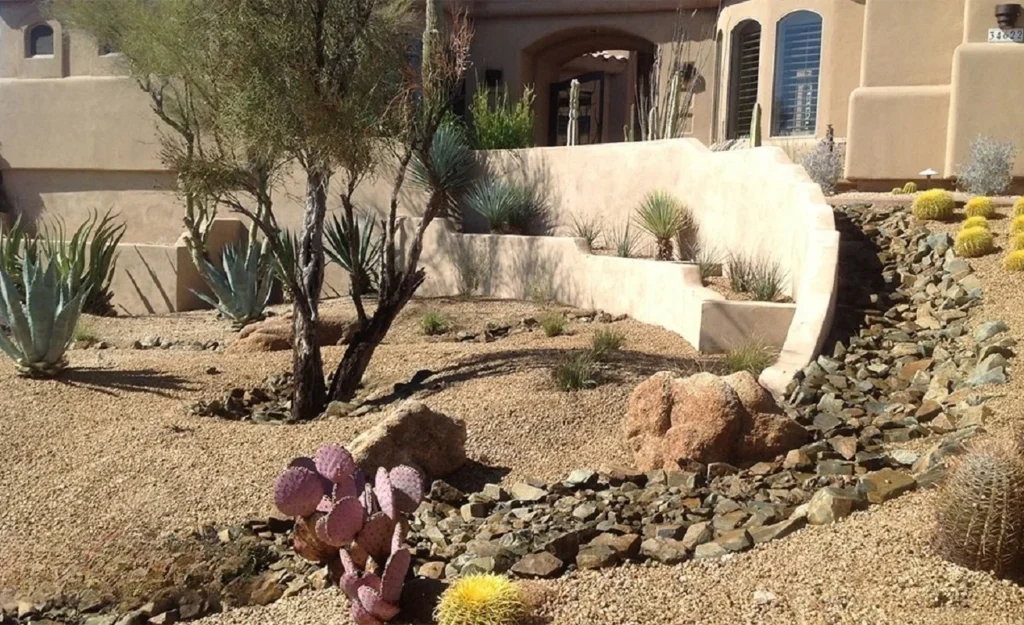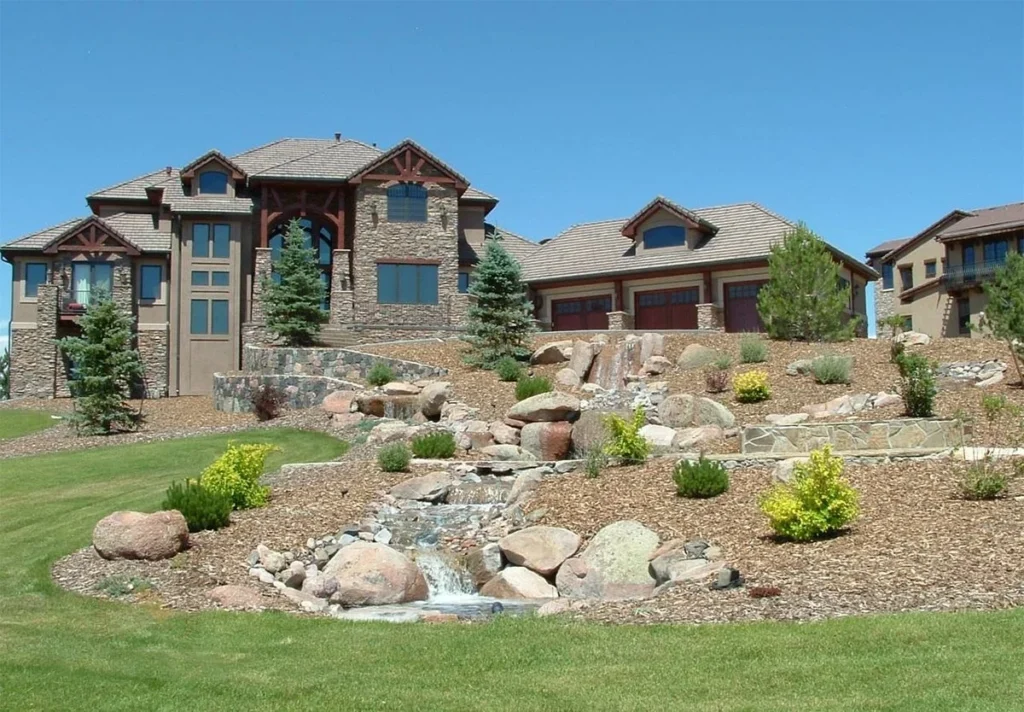
Man and nature are the eternal themes of any kind of art. Landscape design is not only a way of self-expression but also a part of direct communication with pristine nature. Landscaping in the desert or an area where the weather is hot is a bit challenging. Mostly grass and plants are used for exterior décor but due to high temperature and lack of water in the desert, the plants and grasses either wither or die. And in such a case, if your account does not allow much spending, then it seems impossible to decorate the garden at home. In this sense, our home décor experts shortlisted the 10 best inexpensive desert landscaping ideas for your home.
Desert landscaping is a type of landscaping that is designed specifically for arid or semi-arid regions where water is scarce and temperatures are high. The purpose of desert landscaping is to create an aesthetically pleasing outdoor space that is also sustainable and requires minimal water usage.
Desert landscaping typically involves the use of drought-resistant plants that are native to the region, such as cacti, succulents, and other plants that can survive in arid conditions. These plants are often arranged in natural-looking clusters or groupings, and they may be complemented by rocks, gravel, or other natural elements that add texture and interest to the landscape.
10 Inexpensive Desert Landscaping Ideas
Landscaping can be a great way to enhance the beauty of your home’s exterior and improve its overall curb appeal. Here are some ways that you can incorporate desert landscaping into your home decor:
1. Xeriscape

Xeriscape is one of the most popular desert landscaping designs. This is a low-water and low-maintenance garden design that uses drought-resistant plants, rocks, and gravel.
Use decorative pots or containers to showcase your plants.
2. Sonoran Landscape

Named after the Xeriscape, this landscaping features plants such as saguaro cacti, agave, and yucca.
Use a drip irrigation system to water your plants. This will help conserve water and reduce your water bill.
3. Desert Rock Garden

A garden that primarily features rocks and boulders with a few desert-adapted plants that can grow in rocky soil.
You can incorporate rocks and boulders into this landscape design. This will add visual interest and help prevent erosion
4. Tuscan Landscape

The design is inspired by the rustic Italian countryside, and desert landscape with olive trees, lavender, and other Mediterranean plants.
5. Sand Dune Landscape

A landscape design that features the undulating sand dunes of a desert, with occasional tufts of drought-resistant grasses and shrubs.
You can use drought-resistant ground covers, such as ice plants or creeping thyme, instead of grass.
6. High Desert Landscape

A landscape design that features plants such as sagebrush, juniper trees, and desert marigolds, which can withstand harsh, high-altitude conditions.
Incorporate succulents, such as aloe vera or agave, into your landscape design. These plants are low maintenance and add visual interest.
7. Southwestern Landscape

This desert landscaping is characterized by the use of gravel or crushed rock to cover large areas of your yard. This will not only add visual interest but also help prevent erosion.
Create a raised bed using rocks or concrete blocks. This will help keep your plants contained and add visual interest.
8. Pathway Landscape

Create pathways using sand, gravel, or crushed rock. This will provide a clear walking area and add texture to your landscape.
Use outdoor lighting to highlight your landscape design at night.
9. Mediterranean Landscape

A desert landscaping that features plants that are native to Mediterranean regions, such as rosemary, lavender, and olive trees.
You can use your native plants in this landscape design. These plants are well-suited to the local climate and require less maintenance and water.
10. Arizona Landscape

A desert landscape that features plants such as saguaro cactus, prickly pear, and palo verde trees, which are commonly found in Arizona.
You can add recycled materials, such as old tires or pallets, to create unique planters or garden features.
The Best Plants to Use in a Desert Landscape
Designing a desert landscape can be challenging, as the hot and dry conditions make it difficult for most plants to survive. However, there are many plant species that are well-suited to the desert environment and can add beauty and interest to your landscape. Here are some of the best plants to use in a desert landscape, along with some details about their characteristics and care
Agave
Agave is a succulent plant that is native to the desert. It has fleshy leaves that are arranged in a rosette pattern and can grow up to 6 feet tall. Agave plants require little water and prefer well-drained soil. They also require plenty of sunlight, making them an ideal plant for a desert landscape.
Yucca
Yucca is another succulent plant that is native to the desert. It has sword-like leaves and a tall, spiky flower stalk that can reach up to 8 feet tall. Yucca plants require little water and prefer well-drained soil. They also require plenty of sunlight, making them an ideal plant for a desert landscape.
Desert Willow
Desert Willow is a small tree that is native to the desert. It has slender leaves and produces beautiful pink or purple flowers in the spring and summer. Desert Willow trees require moderate water and prefer well-drained soil. They also require plenty of sunlight, making them an ideal plant for a desert landscape.
Ocotillo
Ocotillo is a unique plant that is native to the desert. It has long, spiky stems that are covered in thorns, and produces beautiful red flowers in the spring and summer. Ocotillo plants require little water and prefer well-drained soil. They also require plenty of sunlight, making them an ideal plant for a desert landscape.
Palo Verde
Palo Verde is a small tree that is native to the desert. It has green bark and produces beautiful yellow flowers in the spring. Palo Verde trees require moderate water and prefer well-drained soil. They also require plenty of sunlight, making them an ideal plant for a desert landscape.
Desert Marigold
The Desert Marigold is a small, flowering plant that is native to the desert. It produces beautiful yellow flowers in the spring and summer and requires little water. Desert Marigold plants prefer well-drained soil and plenty of sunlight, making them an ideal plant for a desert landscape.
Saguaro Cactus
The Saguaro Cactus is an iconic plant that is native to the desert. It can grow up to 40 feet tall and has a distinctive shape with arms that curve upward. Saguaro Cacti require little water and prefer well-drained soil. They also require plenty of sunlight, making them an ideal plant for a desert landscape.
Joshua Tree
The Joshua tree is a large, slow-growing evergreen plant that is native to the southwestern United States, particularly the Mojave Desert. This unique tree can live for hundreds of years, with some specimens estimated to be over a thousand years old. It’s named after the prophet Joshua from the Bible.
Joshua trees have been traditionally used by indigenous communities for a variety of purposes, including as a source of food, fiber, and medicine.
Barrel Cactus
This cactus gets its name from its shape, which resembles a barrel. It’s found in the deserts of Arizona, California, and Mexico. They typically grow up to 3-4 feet tall and 1-2 feet wide. The barrel cactus has many ribs that run vertically along its surface and are covered in rows of spines. At the top of the cactus, there are small yellow, orange, or red flowers that bloom in the summer.
Prickly Pear
Prickly Pear is also known by its scientific name, Opuntia. It’s found in the deserts of the southwestern United States and Mexico. Prickly pear cacti have flat, rounded pads that are covered in small spines and larger, barbed spines called glochids. The pads can range in size from a few inches to over a foot in diameter, depending on the species. The cactus also produces bright yellow, orange, or red flowers in the summer and early fall, followed by edible fruit that is typically purple or green.
The fruit of the cactus is edible and can be eaten raw or cooked, and is used to make jams, jellies, and drinks. The pads of the cactus can also be eaten after the spines and glochids are removed, and are used in traditional dishes in many cultures.
Tips for Plant Maintenance in Hot and Dry Weather
- During hot and dry weather, plants need more water than usual. Water them deeply and regularly to keep the soil moist. However, make sure you do not over-water the plants as it can lead to root rot.
- Adding a layer of mulch around the plants can help to retain moisture in the soil and prevent it from drying out too quickly. Mulch can also help to keep the soil cool and suppress weeds.
- If your plants are exposed to direct sunlight, provide them with some shade by using umbrellas or by placing them under a shade cloth. This can help to protect them from the heat and reduce water loss through transpiration.
- During hot and dry weather, plants may not be able to absorb nutrients properly, and fertilizing can actually harm them. Wait until the weather cools down before fertilizing.
- Removing dead or damaged foliage from plants can help to reduce water loss through transpiration and improve air circulation, which can help to prevent disease.
- Drip irrigation is an efficient way to water plants during hot and dry weather. It delivers water directly to the roots, reducing water loss through evaporation and ensuring that plants receive a consistent supply of water.
Final Thoughts
Desert landscaping can be a beautiful and sustainable option for those living in arid climates or anyone who wants to create a unique and visually appealing outdoor space. By incorporating native plants, natural elements, and creative design ideas, you can create a beautiful and low-maintenance desert landscape on a budget. Additionally, by utilizing eco-friendly practices such as drip irrigation and using recycled materials, you can make your desert landscape even more sustainable and environmentally friendly. With a little creativity and some simple tips and tricks, you can transform your outdoor space into a stunning desert oasis.
We hope you found this article helpful. If you did, be sure to check out our blog for more great content like this.





